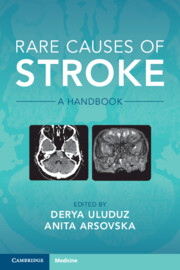Book contents
- Rare Causes of Stroke
- Rare Causes of Stroke
- Copyright page
- Contents
- Contributors
- Preface
- 1 Inflammatory Conditions
- 2 Infectious and Postinfectious Vasculitis
- 3 Hypercoagulable Causes of Stroke
- 4 Drug-Related Stroke
- 5 Hereditary and Genetic Causes of Stroke
- Chapter 5.1 Genetic Collagen Disorders
- Chapter 5.1 Chapter
- Chapter 5.2 Genetic Small-Vessel Diseases
- Chapter 5.3 Genetic Metabolic Diseases
- 6 Rare Causes of Cardioembolism
- 7 Vasospastic Conditions and Other Vasculopathies
- 8 Other Non-inflammatory Vasculopathies
- 9 Venous Occlusive Conditions
- 10 Bone Disorders and Stroke
- Index
- References
Chapter 5.1 - Chapter
from 5 - Hereditary and Genetic Causes of Stroke
Published online by Cambridge University Press: 06 October 2022
- Rare Causes of Stroke
- Rare Causes of Stroke
- Copyright page
- Contents
- Contributors
- Preface
- 1 Inflammatory Conditions
- 2 Infectious and Postinfectious Vasculitis
- 3 Hypercoagulable Causes of Stroke
- 4 Drug-Related Stroke
- 5 Hereditary and Genetic Causes of Stroke
- Chapter 5.1 Genetic Collagen Disorders
- Chapter 5.1 Chapter
- Chapter 5.2 Genetic Small-Vessel Diseases
- Chapter 5.3 Genetic Metabolic Diseases
- 6 Rare Causes of Cardioembolism
- 7 Vasospastic Conditions and Other Vasculopathies
- 8 Other Non-inflammatory Vasculopathies
- 9 Venous Occlusive Conditions
- 10 Bone Disorders and Stroke
- Index
- References
Summary
In 2011, a 10-year-old boy came to the ER for recurrent epistaxis. His medical history showed frequent episodes of headache and epistaxis; otherwise, he had a regular life, good school profile and practiced regular physical activity. His father, affected by cerebral arteriovenous malformation (AVM), has been diagnosed with hereditary hemorrhagic telangiectasia (HHT – also called Osler–Weber–Rendu syndrome). On admission, he was asymptomatic and his blood work was within normal limits.
- Type
- Chapter
- Information
- Rare Causes of StrokeA Handbook, pp. 228 - 233Publisher: Cambridge University PressPrint publication year: 2022

